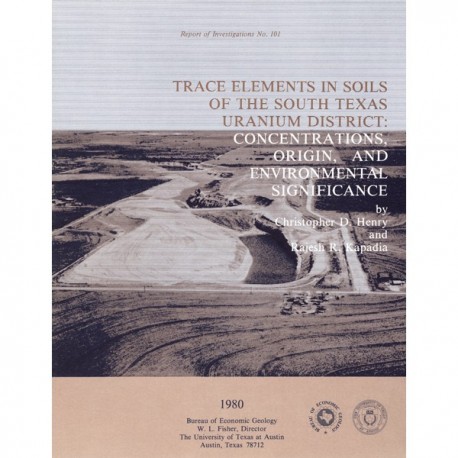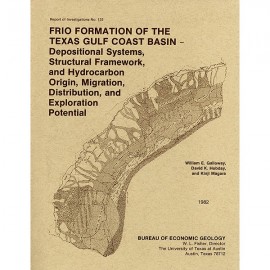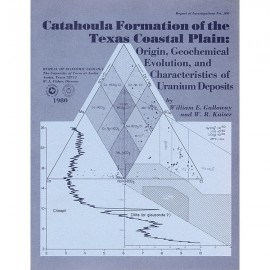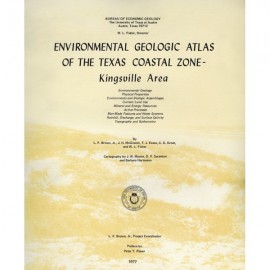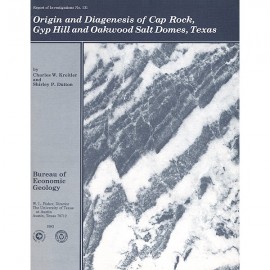Reports of Investigations
-
Books & Reports
- Reports of Investigations
- Guidebooks
- Udden Series
- Geological Circulars
- Down To Earth
- Atlases of Major Oil and Gas Reservoirs
- Texas Memorial Museum Publications
- Environmental Geologic Atlas of the Texas Coastal Zone
- Mineral Resource Circulars
- Other Reports
- Seminars and Workshops
- Handbooks
- Submerged Lands of Texas
- Symposia
- Annual Reports
- Open File Reports
-
Maps & Cross Sections
- Thematic Maps
- Miscellaneous Maps, Charts & Sections
- Geologic Atlas of Texas
- STATEMAP Project Maps
- Geologic Quadrangle Maps
- Cross Sections
- Highway Geology Map
- Energy and Mineral Resource Maps
- Shoreline Change and Other Posters
- Wilcox Group, East Texas, Geological / Hydrological Folios
- Bouguer Gravity Atlas of Texas
- River Basin Regional Studies
- Featured Maps
- Posters
- Teachers & the Public
-
Geological Society Publications
- Gulf Coast Association of Geological Societies
- Alabama Geological Society
- Austin Geological Society
- Corpus Christi Geological Society
- Houston Geological Society
- Lafayette Geological Society
- Mississippi Geological Society
- New Orleans Geological Society
- South Texas Geological Society
- GCS SEPM Publications
- Historic BEG & UT Series
Trace Elements in Soils of the South Texas Uranium District: Concentrations, Origin, and Environmental Significance
RI0101
Trace Elements in Soils of the South Texas Uranium District: Concentrations, Origin, and Environmental Significance, by C. D. Henry and R. R. Kapadia. 52 p., 23 figs., 6 tables, 1980. ISSN: 0082335X: Print Version.
A free, digital version of this publication can be found on: Texas ScholarWorks
RI0101. Trace Elements in Soils of the South Texas Uranium District: Concentrations, Origin, and Environmental Significance, by C. D. Henry and R. R. Kapadia. 52 p., 23 figs., 6 tables, 1980. ISSN: 0082335X: Print.
To purchase this publication as a downloadable PDF, please order RI0101D.
ABSTRACT
The environmentally sensitive trace elements molybdenum, arsenic, and selenium are concentrated with uranium in ore deposits in South Texas. Cattle grazing in some pastures in mining areas have contracted molybdenosis, a cattle disease resulting from an imbalance of molybdenum and copper. To determine natural concentrations of the elements in soils in the South Texas area and to evaluate possible effects of mining on adjacent agricultural land, two sets of soil samples were collected and analyzed for molybdenum, arsenic, selenium, and copper. Two hundred and fifty-six samples were collected in a statistically random design from soils developed on the Whitsett Formation, Catahoula Formation, or Oakville Sandstone, the major uranium hosts of the area, and 182 samples were collected nonrandomly from areas of mining or mineralization to test specific hypotheses concerning the presence and origin of anomalously high concentrations of the elements.
Results of the random sampling show that the different geologic formations have different characteristic trace element concentrations. The Whitsett Formation has higher molybdenum (resulting from minor near-surface mineralization) and lower copper concentrations than the other two formations. With the exception of molybdenum in the Whitsett Formation and copper in all three formations, the trace element concentrations are similar to published average concentrations in soils worldwide.
Sampling in areas of mining and mineralization indicates that high concentrations of molybdenum, arsenic, or selenium occur dominantly in two situations: (1) in areas of shallow mineralization, resulting from natural processes, and (2) in drainages adjacent to older abandoned mines, resulting from runoff from the mines. Moderately high concentrations also occur in a few reclaimed areas. Windblown dust from mining areas has not measurably affected trace element concentrations in adjacent areas.
Comparison of molybdenum and copper concentrations in soils and grasses and theoretical considerations of the availability to plants of molybdenum and copper in soils suggest that forage in much of the area studied could have anomalously low copper/molybdenum ratios-low enough to induce molybdenosis in cattle.
Keywords: South Texas Uranium District, soils, uranium, trace elements, molybdenum, copper, Karnes County, Live Oak County, Texas
Citation
Henry, C. D., and Kapadia, R. R., 1980, Trace Elements in Soils of the South Texas Uranium District: Concentrations, Origin, and Environmental Significance: The University of Texas at Austin, Bureau of Economic Geology, Report of Investigations No. 101, 52 p.
